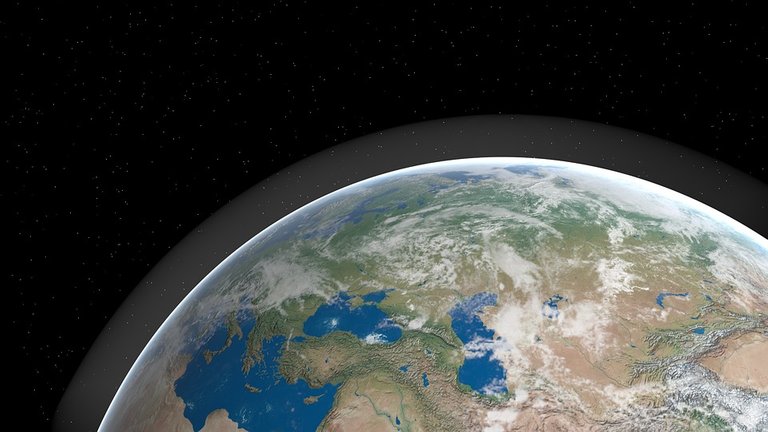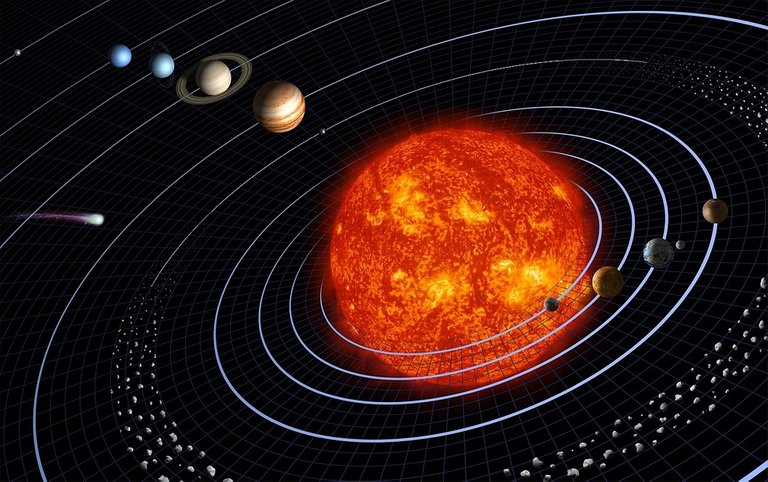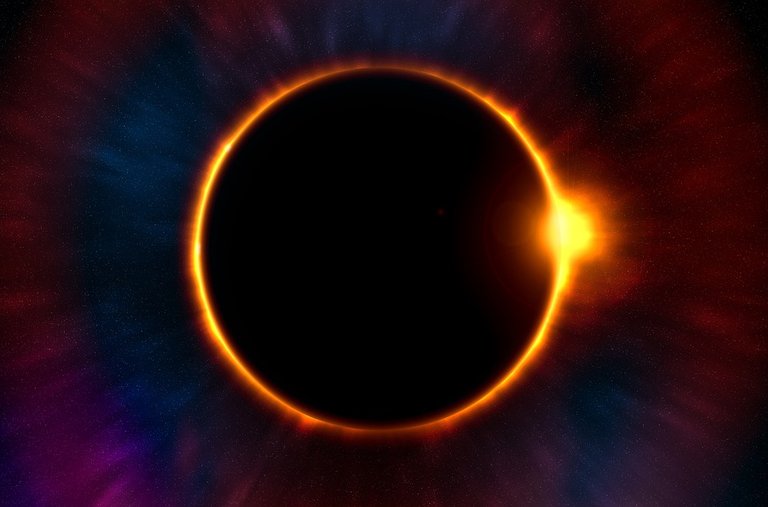Hey everyone!
What's been up? Let's all have a wonderful weekend and maybe take some time to relax. As far as I'm concerned, another day means another desperate attempt to test your patience with a scientific blog. Geodesy strikes back. No time to waste though, so let's get this started. I'm always in a hurry.
As promised in my previous introductory post about Geodesy, this is my second blog regarding the science of observing and measuring our planet's shape and size. This time I'm taking the chance to share some technical information regarding our planet's subsoil and substrates. I will also talk about tectonic plates and share general information regarding the Earth's Motions, so try to stay focused!
As I mentioned, these are still introductory posts so I will try to keep things simple and fun. That means we will discuss some broad information in a humoristic manner. Jokes on me. You might learn a thing or two, so stay with me!

Image Source: pixabay.com
History
Plato (428 BC. - 348 BC.) was the first one to ever state that the Earth was round. He described our home planet as a huge sphere which is isolated and motionless, situated in the middle of the Universe. Aristotle (384 BC. - 322 BC.), Plato's student, supported the same theory based on corollaries mentioned in his writings. He basically utilized observations of the Earth's circular shadows casted on the lunar surface during an eclipse, and the change of positions of the Sun and other stars as perceived by an observer moving towards the North. However, Eratosthenes (276 BC. - 194 BC.) is considered as the father of Geodesy, being the very first to ever measure the Earth's size, as explained in a previous post. Eratosthenes' measurements and calculation induced a -2% error in the final estimation of the Earth's radius, producing a value of 6267km instead of the actual known size of 6371km. Isn't that amazing? He calculated the Earth's radius with such precision without using computers.
After a long time and during the 1700s multiple attempts to measure and precisely define the Earth's radius started taking place. In 1672, french astronomer Jean Picard (1620 - 1682) applied the exact same method with the slight but yet important difference of utilizing a telescope. The error included in his final estimations was roughly +1%, providing a value of 6372km. A value that later actually helped Newton achieve verification of the law of Gravity. However, during the very same year scientists started casting doubts on the spherical Earth theory, especially due to statements made by french Astronomer Jean Richer (1630-1696). He basically observed that there were slight differences (2.8mm) in the length of threads used in pendulum clocks that where being utilized back then to track time, situated in South America and Paris. Thankfully, it was just 15 years later when Isaac Newton (1642 - 1726) stated that the Earth's shape might actually be flattened at the poles, forming an ellipsoid figure which could serve as a credible explanation of the laws of Gravity and Motion.

Ellipsoid Revolution Oblate./ Image Source: commons.wikimedia.org
Newton's observations and assumptions fueled further reasearch in pursuit of the truth and inevitably lead to the creation of the first third dimensional models of the Earth that were flattened at the poles. Newton formulated the basic principles of centrifugal force which provided the initial plummet values of 1/230 and 1/578. Nowadays' advanced satellite and computers systems have assisted engineers in estimating a plummet value of approximately 1/298. Friedrich Bessel (1784 - 1846) measured an arc on a meridian in eastern Prussia and managed to calculate the dimensions necessary (a= 6378397,155m_ f=1/299.153) in order to establish the Bessel Ellipsoid. This ellipsoid was broadly used in a number of European countries including Greece. The next signs of significant change came during the 1900s , an era that provided many opportunities for scientific growth. For the first time ever it was possible to precisely define the Geoid and therefore reach more accurate conclusions regarding the reference ellipsoids' abstention. This provided engineers with the ability to produce quality ellipsoids with much more precision. The main reference ellipsoids of this era are: the ellipsoid of Friedrich Helmert (1843 - 1917) (a=6378200m_ f=1/298.3) and the ellipsoid of John Hayford (1868 - 1925) (a=6378388m_ f=1/297).
Inevitably, confusion prevailed in scientific and engineering communities due to the fact that all countries starting using their own reference ellipsoids. Cooperation and accurate communication between engineers of neighbour nations was getting harder and harder. Different reference ellipsoids were making it hard to compare geodetic data and estimations in areas close to neighbour countries' borders. The International Union of Geodesy and Geophysics decided to declare and establish the Hayford Ellipsoid as the official international reference ellipsoid. This specific reference ellipsoid was the one used in the first European triangulation (European Datum 1950, E.D.50), which was initiated in Potsdam, Germany. In 1980 the IUGG substituted the Hayford Ellipsoid with GRS80 (a=6378137m_ f=1/298.257), which is used until today.

Image Source: pixabay.com
A few words about our beautiful planet.
Planet Earth is the third planet of our solar system in terms of distance from the Sun and the fifth one in terms of size. The Earth was born roughly 4.5 billion years ago and has its own atmosphere, magnetosphere ionosphere and hydrosphere. Being the only planet in the solar system with vast amounts of liquid water on its surface, planet Earth has a unique importance. More than 70% of the planet's surface is covered by water, while its topographic surface occupies less than 28% of its total area despite its wide range and variety. Our planet's surface is highly irregular, which is one of the basic reasons why it can't be accurately described using mathematical equations. It can definitely be considered spherical though, as the anomalies demonstrated are rather negligible taking into consideration the fact that the planet's radius is 6371km while the biggest anomalies (Everest, Mariana Trench) are slightly smaller than 8,9km and 10,6km. Last but never least, the Earth has the biggest average density in the solar system.
A few fun numbers regarding the Earth:
- Surface Area : 5.1 x 10^18cm^2
- Mass : 5.9742 x 10^27gr
- Average Density : 2.67gr/cm^3
- Escape Speed : 11180km/sec
Internal Structure and Composition
The planet's internal structure is mainly composed of rocks and metals in various chemical compounds. There are 4 basic categories:
Internal Core : Consists of solid metal comprised of Fe and Ni and has a diameter of approximately 1220km. Density in the internal core's center can reach values of 13gr/cm^3.
Outer Core : Consists of a liquid fervid layer comprised of Fe and Ni with a depth of 2265km. Density close to the mantle can reach values of 9.9gr/cm^3, while density close to the internal core can reach values of 12.7gr/cm^3.
Mantle : Consists of a high density layer comprised of mainly silicate rock with a depth of approximately 2850km. Density has a value of roughly 5.7gr/cm^3.
Crust : Consists of silicate rock formations. It's depth is not fixed and ranges from 5km to 65km thick. Density values can climb up to 3.3gr/cm^3.
Now let's take a deeper look at the Earth's internal structure and composition.
Concerning our planet's internal structure, engineers have developed alternative methods of classifying the first 400km of substrates by creating two broad categories: the lithosphere and the asthenosphere. The lithosphere is the outer substrate reaching depths of 75-100km. The crust belongs in the lithosphere and therefore provides great stiffness and resistance properties. That is the main reason why this specific substrate can gather mechanical tension which in return creates earthquakes.
The next substrate that we meet moving towards the Earth's core is the so-called asthenosphere, also known as upper layer of the mantle. Reaching depths ranging from 100km to 400km results in high temperature and pressure conditions. Temperatures reach the mantle's melting point. As a result, inductive currents are produced within the fervid mantle's interior which in return transmit heat towards the colder upper layers. Those conductive currents' occurence is probably the main factor causing the lithospheric plates' motions. It is also believed that the Earth's magnetic field is generated by those currents' motion.

Image Source: schoolphysics.co.uk
It is a known fact that the Earth's crust is thinner beneath the ocean and is mainly comprised of silicon dioxide. The Earth's crust can reach depths of 65km and is totally solid, just like the internal core. The rest of the substrates occur in a semi-fluid, plastic state due to ideal specific combinations of temperature and pressure. Temperatures within the internal core can reach up to 7500K , which is higher than the Sun's surface temperature. However, the Sun's core reaches temperatures of more than 15 000 000K. Calm down, Earth. As mentioned above, the Earth is the celestial body with the highest average density in our solar system. The Earth's chemical composition is demonstrated below:
- Crude Iron : 34.6%
- Oxygen : 29.5%
- Silicon : 15.2%
- Μagnesium : 12.7%
- Nickel : 2.4%
- Sulfur : 1.9%
- Titanium : 0.05%
The crust's main characteristic is the fact that it is comprised of a number of different solid plates which are situated on top of the mantle's upper layers according to the theory of tectonic plates. Nowadays there are 8 major tectonic plates and more than 20 smaller ones. Those plates in some cases move away form each other, and therefore give birth to new parts of the crust as the product of the emerging magma's presence. In other cases, tectonic plates collide with each other, resulting in the edge of one of the plates involved in the collision being destroyed and inevitably drowned within the other plate's mantle.
Earthquakes happen more frequently close to the confines between tectonic plates, so engineers are able to gather spatial information and map tectonic plates' confines more precisely. The Earth's Surface Age is approximately 500 000 000 years, which means that the surface is relatively young compared to the planet's age. Various tectonic processes and corrosion play an important role in destroying and rebuilding the Earth's surface. Lost recent geological traces are the consequences of this never ending process. The presence of vast amounts of water in liquid state along with the ocean's heat capacity are the main factors contributing in the stability of temperature which provides the conditions necessary for life to thrive on Earth.

Average Chemical Composition of Crust, Hydrosphere and Troposphere./ Image Source: castlelearning.com
The Earth's Motions (a general introduction)
Our planet moves along with our Galaxy through the Universe. It also moves together with the rest of our solar system inside our Galaxy. It needs approximately 364 days to revolve around the Sun and roughly 24 hours to rotate on its axis, while its rotary axis moves periodically, shaping a cone trace. Furthermore, the Earth's tectonic plates' motions are also considered motions of the Earth. Geodesy as a scientific field focuses on all those different sorts of motions which are observed and studied separately. The Earth's angular velocity is approximately 7.292e-05 rad/s (7.292 x 10^-5 rad/s), however the interaction between the Earth and the Moon results in a decrease of 2 miliseconds per century. The Earth's magnetic field which is produced by the inductive electric currents of the internal core interacts with the solar wind, which is basically a constant flow of electrically charged particles and especially protons and electrons, creating various phenomena like the Northern Lights.
The estimation of the Earth's angular speed refers to points or observers situated on the Equator. In any other place of the sphere, the speed can be estimated using the formula: (1667 x cosφ)km/h, φ being the value of geographic latitude in degrees. In reality, the Earth rotates on its axis once every 23 hours 56 minutes & 4.09053 seconds, this is also known as the Earth's astral cycle, mainly because the planet's orbital motion is slightly changed before one full rotation is completed. Therefore, the Earth needs roughly 4 more minutes of rotation in order to achieve the same position it actually occupied in regards to the Sun 24 hours earlier. Furthermore, the Earth revolves around the Sun at an orbital velocity of 107306km/h or approximately 30km/s. The planet also moves together with the Sun around the center of the Galaxy. The slope of the Earth's rotary axis in regards to the Earth's ecliptic motion is approximately 23,2 degrees. Don't underestimate this slope; it is the reason we have four seasons on Earth.

Our Solar System./ Image Source: pixabay.com
The belief that the Earth revolves around the Sun was expressed from the ancient times, but wasn't supported by credible scientific evidence at all, until the phenomenon of astral diversion was observed and discovered in 1725. This phenomenon is the reason why the position of stars as observed in the Earth's sky changes every year due to the planet's revolution around the sun. Astral parallax, which is the observed motion and change of position of stars due to the planet's change of position in relation to those stars, is another piece of scientific evidence regarding the Earth's revolution around our solar system's star. The magnitude of parallax depends on each stars distance from the Earth and is usually rather small due to the extremely large distances between our green home and the stars observed. Poor Aristotle believed that the Earth was motionless only because he had no telescopes available.
He also lacked information. Astral parallax couldn't have been observed without the utilization of advanced technological means, however he probably could have guessed or assumed its existence if he actually knew how distant those stars in the night sky actually were. In order to comprehend the phenomenon of parallax, one has to place an object close to their eyes, for instance a finger, and try to observe the seeming change of position in regards to the background by blinking successively. The more distant an object actually is, the less significant parallax involved. One more piece of scientific evidence that the Earth is constantly moving is the Doppler phenomenon. It's been observed that the light received from distant stars as the Earth revolves around the Sun is frequently changing wavelength, which is an indicator that our planet is moving closer or farther away from those stars.

Solar Eclipse./ Image Source: pixabay.com
Hope you made it till this point! That was the second part regarding this Introduction to Geodesy. Let me know if you have any questions in the comments below and I will provide detailed answers. My next and final blog regarding this Introduction to Geodesy series will be published within the next 3 days, so stay tuned! Follow me at your own risk! :)

IMAGE SOURCES:
REFERENCES:
University Textbooks & Lecture Notes:
Eισαγωγή στη Γεωδαισία / Ιntroduction to Geodesy - TELIONI ELISSAVET (National Technical University of Athens, School of Rural and Surveying Engineering course lectures)
Γεωμετρική Γεωδαισία, Εκδόσεις ΖΗΤΗ / Geometric Geodesy, ZHTH publications. - FWTIOU ARISTIDIS (National Technical University of Athens, School of Rural and Surveying Engineering university textbook)
Δορυφορική Γεωδαισία/ Satellite Geodesy - ΜILAS PARASKEVAS (National Technical University of Athens, School of Rural and Surveying Engineering course lectures.)
Aνώτερη Γεωδαισία / Τοp Geodesics - BITHAS ANASTASIOS (National Technical University of Athens, School of Rural & Surveying Engineering course lectures)
Internet Links:


Thank you for your attention!
Hope you enjoyed this post and did learn a thing or two.
Follow me and stay tuned for more engineering blogs.
Highest Regards
@lordneroo
Being A SteemStem Member
Are you sure earth is not flat bro? 😝😝
Nice article!
Thanks!@mcandceo I'm positive!
Me gusto mucho tu analisis y creo que tienes mucha razón :D
Gracias por tus amables palabras ;)
Para eso estamos amigo :D
A great piece of information 👊🏽👊🏽
Thanks!